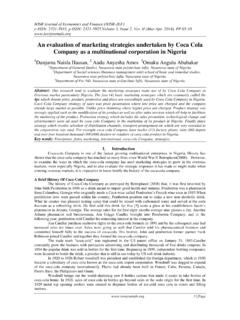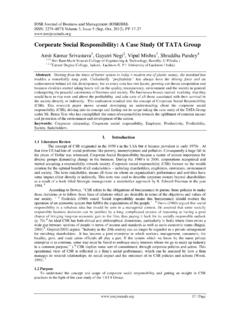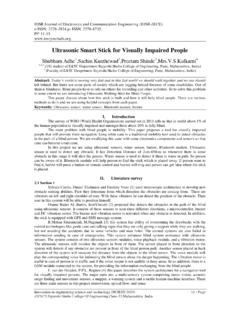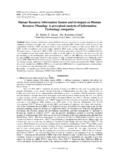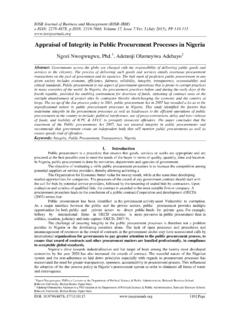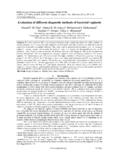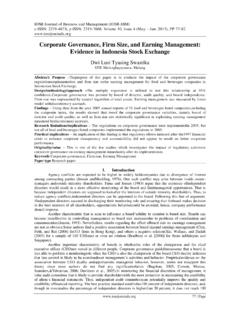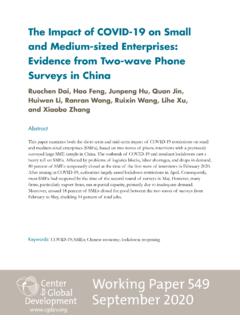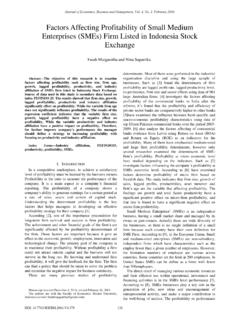Transcription of An investigation into the challenges faced by Small to ...
1 IOSR Journal of Business and Management (IOSR-JBM). e-ISSN: 2278-487X, p-ISSN: 2319-7668. Volume 18, Issue 9 .Ver. II (September. 2016), PP 148-153. An investigation into the challenges faced by Small to medium Enterprises in Zimbabwe: A case of Gazaland Market Rutendo Tinarwo*. *Management College of Southern Africa (MANCOSA) 16 SamoraMachel Street Durban, KZN, South Africa Abstract: The main objective of the study was to assess and establish the challenges which are faced by the Small and medium enterprises that hinder their performance and limit their growth. The study was relied upon Small to medium Enterprises (SMEs) which are operating at Gazaland Market. Primary data were obtained mainly from semi-structure questionnaires. Observations, verbal interviews and face to face interviews were however also used to complement the data that was obtained from the use of questionnaire.
2 Secondary data used was extracted from newspapers, journals, reports, textbooks, and articles presented by other authors on SMEs. The study revealed the major challenges hampering the growth of SMEs at Gazaland Market cut across lack of markets, lack of government support, unfair treatment from the local authority, stiff competition due to cheap imports, finance, and lack of training as well as technology. On the some minor challenges hampering them from transiting into formal business include poor infrastructure and lack of trust from the suppliers. Keywords: challenges , Growth,Hinder, Performance, SMEs I. Introduction Zimbabwe has witnessed a high number of growths in the number of business start-ups during the past twenty years. According to (Gono 2005:8) SME sector in Zimbabwe contributes to the national economy in different ways which include employment creation, national economic development and adding value to the gross domestic product (GDP) of the country.
3 The Reserve Bank of Zimbabwe (2013:28), postulate that the SMEs constitute 50% of the Zimbabwean GDP and 60% of the economy. Given the information base and productive resource endowment of Zimbabwe, the country is projected to be the leader in growth among the Sub-Saharan African countries towards 2020 (Zindiye et al. 2012:666). Ncube and Greenan (2004:6) estimated that there are about 609 SMEs in the manufacturing sector of Harare. Machipisa (2008:20) argued that there are 10 000 SMEs in Zimbabwe which controls 65% of the total corporate purchasing power. According to (Scholgl 2004:46) SMEs in Zimbabwe forms an important component of the economy. Tsarwe (2014:54) ironed out that the future growth of the Zimbabwean economy has been anchored by policy makers on the establishment of growing SMEs in the face of business closures by the large companies due to the economic meltdown.
4 In this regard the Government has been calling for support towards the SMEs, which is recognition of the potential benefits they can contribute to the economy. The Zimbabwe Agenda for Sustainable Social and Economic Development (ZIMASSET) was launched in 2013 with a view to drive economic development anchored to a larger extent on the growth of SMEs and beneficiation of local resources. However, Government support cannot do much in terms of the development of the SMEs but the bulk of the success of SMEs should be generated by the sector players. The Government of Zimbabwe has put efforts to improve the SMEs but with limited success Central Africa Building Society (CABS) and Old Mutual have agreed to avail a total of US$10 million, US$5 million each, towards SMEs Funding. Discussions with other players in the financial sector to contribute another US$10. million are underway, Former minister of Finance, MrTendayiBiti's written presentation (Zimbabwe Independent 23 November 2012).
5 This is attributed to a number of challenges faced by SMES which call for an investigation so that they will be able to fulfil their strategic position in the mainstream economy. Players in this sector are made up of many different people who are in business to benefit or succeed in one way or another. The Government and other stakeholders such as the Non-Governmental Organizations (NGO) have invested resources and expertise to ensure success in SMEs. However the sector has not contributed meaningfully to the country's GDP according to the findings done by the Asia-Pacific Economic Cooperation (APEC), World Bank and Inter-American Development in 2002. It is, however, important to note that a strong institutional framework supporting the development of SMEs is already in place in Zimbabwe, as evidenced by such longstanding institutions as SEDCO, the United Nations Industrial Development Organisation (UNIDO), the International Labour Organization (ILO) arms, among several other institutions which are currently providing technical and financial assistance to the sector (Gono 2006:8).
6 As they benefit, the nation as a whole will also benefit if their efforts are successful endeavours (Goriwondo 2011:354). DOI: 148 | Page An investigation into the challenges faced by Small to medium Enterprises in Zimbabwe: A case of This study aims to investigate the challenges which hinder the growth of SMEs in Zimbabwe using Gazaland Market as a case study. The research builds on the theoretical framework presented and investigates the variables identified in the literature. The research objectives of this study are as follows: To establish the major challenges or constraints which are being faced by the SMEs at Gazaland Market;. To investigate the impact of the challenges on the operations of the SME's at Gazaland Market;. To explore how the challenges faced by SMEs affect the Zimbabwean economy; and To make recommendation of what should be done to improve the operations of the SMEs at Gazaland Market.
7 II. Definition Of SME In Zimbabwe Across all academic disciplines, there is no single universally agreed definition of SME as no single definition can capture all the dimensions of SME nor can be expected to reflect the difference between entities in different industrial sectors or countries at different levels of development. According to (Zindiya et al., 2012:666), most definitions are based on size, and they use fundamental bases such as number of employees, financial position or annual turnover. The constitution of a Small or medium enterprise in relationship to the literature is a major concern according to (Abor and Quartey 2010:218), as different authors have used different definitions due to the concepts which have many components. In Zimbabwe Small Enterprises Development Corporation (SEDCO) (2010:26) has defined a SME as a firm that employ's less than hundred employees and maximum annual sales turnover of US$830 000.
8 Government of Zimbabwe (GoZ) (2000:89) defines a Small enterprise as one that employs not more than 50. people and acting as a registered entity, medium enterprises as firms employing between 75 and 100 people. The Zimbabwe Revenue Authority (ZIMRA) has its own definition for tax purposes and it defines SMEs in terms of employment, turnover and asset base. Table 4: ZIMRA's Definition of SMES. Enterprise Employees Annual Turnover (USD) Asset Turnover (USD) Registration Status Category Small 10 40 50000 500000 Formally registered medium 41 75 1000000-2000000 1000000-2000000 Formally registered Source: ZIMRA (Finance Act ss2b: chapter 23:4). It will be clear and more meaningful if the SMEs are defined by their behavioral and functional attributes than by qualifications of assets turnover and employees. For the purposes of this study a Small and medium Enterprise (SME) refers to a registered or unregistered company which is operating and employs more than 5 employees.
9 III. Roles Of Smes The importance of the SMEs sector is different throughout the world as it differs from country to country in accordance with the level of development, pattern and rate of change in economic development (Kennedy and Hobohm 2012:45). The importance of SMEs in economic development came to light following the success stories of some East Asian and Western European countries such as Singapore, Taiwan, North Korea, Germany and Italy (Hallberg 2011:181). A number of donor agencies and development analysts have called for intensive research in the role of SMEs in industrial and economic development (Havenga 2010:270). After the failure of large companies to generate meaningful employment and industrial development, most governments in Africa have turned to SMEs as a solution. The SME sector is now regarded as a solution to most developmental problems in developing countries (Sibanda 2012:1).
10 According to (Goriwondo 2011:354), SMEs play an important role in the revitalisation process of the economy. It is accepted and acknowledged that SMEs serve as an instrument which is effective in employment creation as well as economic growth, which eventually leads to the reduction of poverty to the entrepreneurs and their employees. The SMEs contribution to the mainstream economic activities will help address the economic ills in the country and many citizens will improve their livelihood. SMEs play a very important role in the growth and development of any nation. Sharma (2011:48) argues that the low income generated in a large number of SMEs is dispersed more widely in the community than the large income generated in a few large companies as the income benefit is derived by a large population while large enterprises encourage more concentration of economic power. SMEs foster entrepreneurship and does not demand high capital or high technology but only require management skills and knowledge to mature the business to big giants in the nation.
